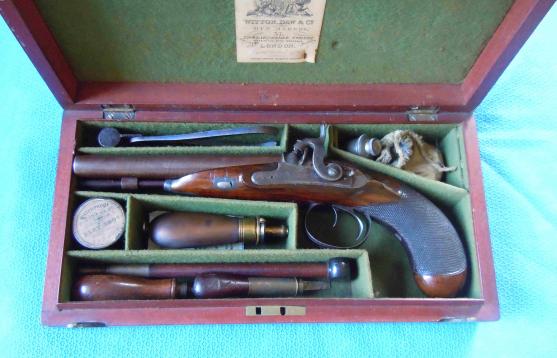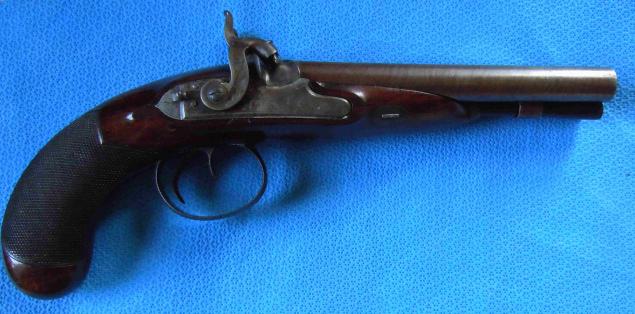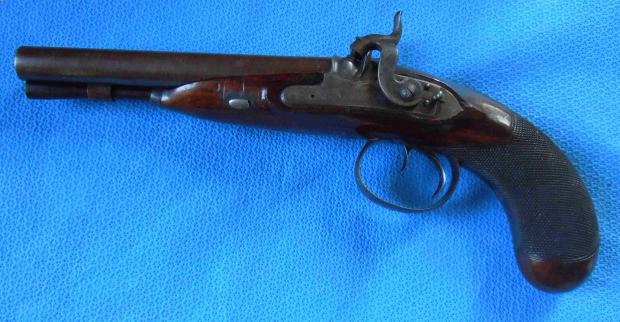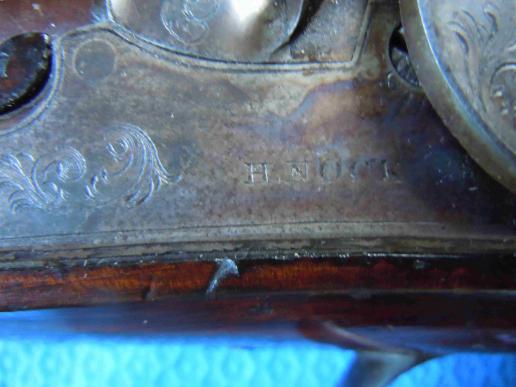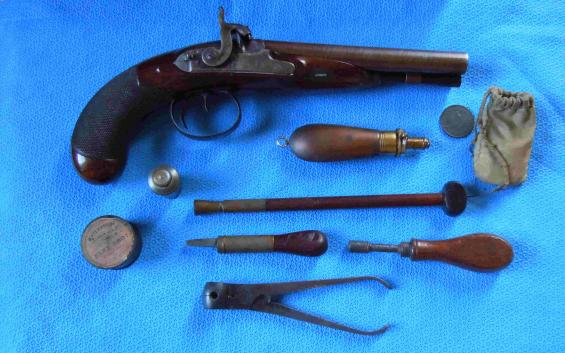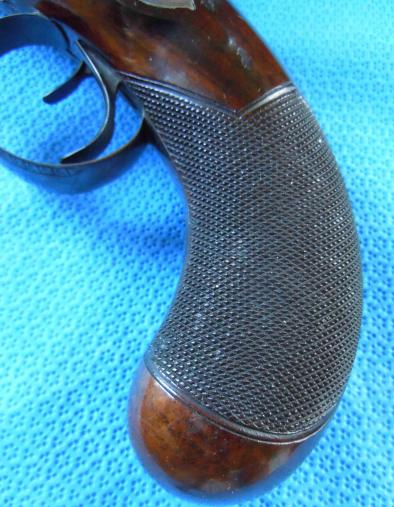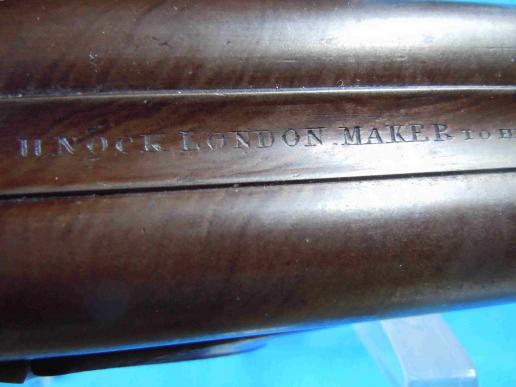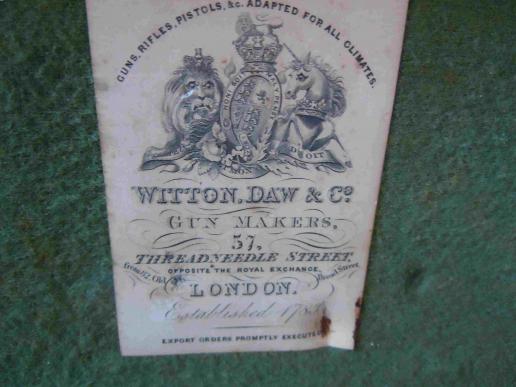Superb Nock Howdah/Travelling Double Barrel Pistol
Excellent H Nock Double Barrelled Travelling Pistol
This is a mahogany cased double barrelled travelling pistol by Henry Nock which started life as a flintlock pistol but was expertly and expensively converted to percussion firing by Witton and Daw and is presented in its Witton and Daw case with original trade label and complimented by its accessories. The quality of this piece is excellent with wonderful 7" brown Damascus steel barrels, original case hardening and perfect lock mechanisms.
The bore of the pistol measures at .57" so approximately 24 bore and the case contains the correct ball mould to suit but also a small leather pouch of swan shot so clearly the original owner meant business and this would have been an intimidating piece to face! Other accessories include a powder flask, additional cleaning rod, oil bottle, turn screw and original box of percussion caps
Both locks function perfectly and are marked H Nock while the top rib bears the engraving "H NOCK LONDON MAKER to his MAJESTY". Bores are perfect. The grip has an un-engraved silver escutcheon and the case a similarly un-engraved brass plaque. The case also contains an 1803 Halfpenny coin which could indicate the manufacturing date and I am told has been with the case since living memory. This is a top of the range pistol by a pre-eminent maker and worthy of any collection as it offers an interesting piece in exceptional condition by a superior maker that exhibits the transition between flintlock and percussion with an expert conversion that cannot be criticised on quality.
Nock was a prolific inventor and is best known for his formidable multi-barrelled volley guns which were purchased by the Royal Navy and in recent years brought back to public notice by the TV series Sharpe in which Sergeant Harper carries a Nock Volley Gun. There is an interesting and erudite article on Nock and his volley guns in the Gun Report magazine of October 1967 and I would be pleased to make a copy for the purchaser of this pistol if interested. Nocks volley gun also formed part of the arsenal of HMS Pandora when she sailed in pursuit of the mutineers of HMS Bounty in 1791.
Howard Blackmore stated that Nock never made an inferior military or civilian gun and his contribution to the advance of gun making in general has sadly been considerably overlooked,
MacDonald Hastings in his book, English Sporting Guns, pages 8 and 9, supports the enthusiasm of
Blackmore , stating:
'HENRY NOCK of London, with his patent (No. 1598) of April 25, 1787, achieved a breakthrough. Prior to his patent, the plug was a solid lump of metal. When the flint sparked the powder in the pan, the flame spurting into the touch hole ignited only a corner of the charge . . . In NOCK's gun, . . . the priming powder fired in the middle of the charge. Guns shot harder and quicker . . . it was from NOCK's patent that gun invention leapt forward.
Another common word we use today in respect of firearms is the 'Knox form' which is a derivative from 'Nocks Form' another of Henry Nock's patented inventions.
Here is a very limited biography of this pre-eminent gun maker.
Henry Nock, Gun maker, London (1741-1804)
Henry Nock opened business in London in 1772, appearing in the rate books for 1772 as a gunlock smith at Mount Pleasant, London.
In April 1775 he formed a partnership with fellow gun makers, William Jover and John Green, to sell firearms made under English Patent No.1095 from 83 Long Acre. By 1779 he had moved to the Whitechapel district and appears at Castle Alley in Whitechapel the following year, 1780. That same year he designed and produced 7-barrelled guns for the Board of Ordnance and followed it up with a screw less lock (1786), a wall piece (1788), the Duke of Richmond's musket (1792), Royal House Artillery pistol (1793) and a cavalry carbine and pistol in 1796.
From 1784 until his death in 1804 he was based at 10 Ludgate Street, with factories at Moses and Aaron Alley, 27 Goulston Street and 9 Castle Alley, Whitechapel. Across the same period he had a shooting ground at Clowters Gardens behind St. George's Church, on Blackfriar's Road. During these years he took out his own patent, English Patent No. 1598 in 1787 for an improved breech design.
Shortly after moving into the Whitechapel district, Nock made a set of gauges for the Gunmakers Company Proof House in 1781, but shortly afterwards severed his ties with the Company by purchasing his freedom in 1784. This move reflected the sentiments of many gun makers who worked outside the Company's control over London's inner city area. Blackmore (1986) describes the situation: 'To the west extending along Fleet Street to the Strand and Charing Cross, and north to Long Acre and Holborn, were new generations of master gun makers who had served their time elsewhere and had no traditions of service with the City Companies.'
From 1771 until 1804 Nock was a contractor to the Board of Ordnance and from 1777 until a year before his death, he was a contractor to the East India Company for the supply of arms.
In July 1778 the Gunmakers' Company, after having argued that the loss of income was in part due to the lack of a Livery, petitioned the Lord Mayor and the Aldermen and were successful. As a result, the Gunmakers Company took its place in the social life of the City and played its part in its business and politics, including the election of Aldermen and the Lord Mayor. Obviously attracted by the newly found status in being attached to the Company, Nock took Livery in 1795 and rose through the ranks to become Assistant in 1792 to finally Master in 1802.
He died in 1804 and was succeeded by his foreman and son-in-law, James Wilkinson (d.1849). James Wilkinson is the Wilkinson behind the famous Wilkinson Sword company who also retailed guns.
Absolutely superlative quality.This gun was probably not fired as a flintlock as it retains too much case hardening and original colour.
Code: 50490

